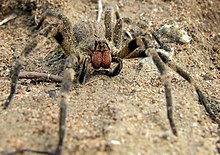Phoneutria
| Phoneutria | |
|---|---|
 |
|
| Phoneutria cf. nigriventer | |
| Scientific classification | |
| Kingdom: | Animalia |
| Phylum: | Arthropoda |
| Subphylum: | Chelicerata |
| Class: | Arachnida |
| Order: | Araneae |
| Infraorder: | Araneomorphae |
| Family: | Ctenidae |
| Genus: |
Phoneutria Perty, 1833 |
| Type species | |
|
Phoneutria fera Perty, 1833 |
|
| Species | |
|
See text |
|
| Diversity | |
| 8 species | |
See text
Phoneutria is a genus of venomous spiders in the family Ctenidae of potential medical significance to humans. They are mainly found in tropical South America, with one species in Central America. Two species, Phoneutria fera and Phoneutria nigriventer, are known as the Brazilian wandering spider; the genus as a whole is sometimes called Brazilian wandering spiders, although not all species occur in Brazil. Other English names include armed spiders (armadeiras in Brazilian Portuguese) and banana spiders (a name shared with several others).
The spiders in the genus can grow to have a leg span of 13 to 15 cm (5.1 to 5.9 in). Their body length ranges from 17 to 48 mm (0.67 to 1.89 in). While some other araneomorph spiders have a longer leg span, the largest Phoneutria species have the longest body and the greatest body weight in this group. The genus is distinguished from other related genera such as Ctenus by the presence of dense prolateral scopulae (a dense brush of fine hairs) on the pedipalp tibiae and tarsi in both sexes.Phoneutria are easily confused with several other non-medically significant ctenids, especially Cupiennius, in which the recently described C. chiapanensis also has bright red hairs on the chelicerae. Additionally, some Phoneutria species lack red hairs on the chelicerae, making it an unreliable identification feature. The presence of a dark linear stripe or stripes on the frontal (dorsal) palps and presence of a single thin black line running anterior-posterior along the dorsal carapace may help identify Phoneutria. Other features are the strong ventral marking on the underside of the legs with contrasting dark mid-segments and lighter joints, and the pattern on the ventral (underside) of the abdomen with several rows of black dots, or an overall reddish colour.
The characteristic defensive posture with frontal legs held high is an especially good indicator to confirm a specimen is Phoneutria, especially alongside correct colour patterns. During the defensive display the body is lifted up into an erect position, the first two pairs of legs are lifted high (revealing the conspicuous black/light-banded pattern on the leg underside), while the spider sways from side to side with hind legs in a cocked position.
...
Wikipedia
